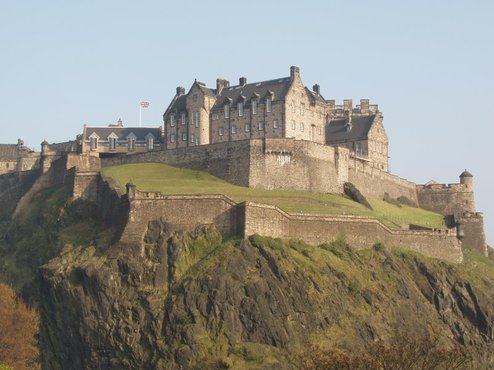I'm a big fan of ghosts - though I haven't seen one yet - and love to hear horror stories that involve such beings. If you didn't get the message until now, yes, I believe in ghosts. And werewolves. And goblins. But those are matters for another day.
Anyway, these days I was googling cool haunted places and was delighted to know that my beloved Scotland is one of the most haunted countries in the world, and home of the so-called most haunted castle of the world: the castle of Edinburgh.
Battles and sieges were fought over it and royalty lived and died within its walls, by natural death or murder. Which probably might have caused the ghastly apparitions. Back in the Iron Age, warriors defended a hill fort there, and the nation's oldest poetry tells of a war band feasting here for a year before riding to their deaths in battle. How merry!
The Scots and English struggled for control of this castle during the Wars of Independence. In 1314 it was recaptured from the English in a daring night raid led by Thomas Randolph, nephew of King Robert the Bruce (friend of William Wallace, remember him?).
The castle has sheltered many Scottish monarchs. They include Queen Margaret (later St Margaret), who died here in 1093, and Mary Queen of Scots, who gave birth to James VI in the Royal Palace in 1566. Her great-great-great grandson Charles Edward Stuart - Bonnie Prince Charlie - captured Edinburgh but was unable to take the castle during the 1745-6 Jacobite Rising.
In 1996, the Stone of Destiny, on which kings were enthroned for centuries, was returned to Scotland. It is now displayed in the Crown Room.
It was also used as army headquarters in the 1600s. Some buildings were rebuilt and new ones were raised to house a huge garrison - and provide a secure jail for prisoners of war. The military presence remains unbroken, but over the last 200 years the castle has become a national icon. It is now Scotland's leading tourist attraction, and a key element of the Edinburgh World Heritage Site.
The castle also houses deep caves, known to refuge Black Plague victims in quarantine. If that doesn't give it a ghost or two, go home, lad, ye're done.
Anyway, these days I was googling cool haunted places and was delighted to know that my beloved Scotland is one of the most haunted countries in the world, and home of the so-called most haunted castle of the world: the castle of Edinburgh.
Battles and sieges were fought over it and royalty lived and died within its walls, by natural death or murder. Which probably might have caused the ghastly apparitions. Back in the Iron Age, warriors defended a hill fort there, and the nation's oldest poetry tells of a war band feasting here for a year before riding to their deaths in battle. How merry!
The Scots and English struggled for control of this castle during the Wars of Independence. In 1314 it was recaptured from the English in a daring night raid led by Thomas Randolph, nephew of King Robert the Bruce (friend of William Wallace, remember him?).
The castle has sheltered many Scottish monarchs. They include Queen Margaret (later St Margaret), who died here in 1093, and Mary Queen of Scots, who gave birth to James VI in the Royal Palace in 1566. Her great-great-great grandson Charles Edward Stuart - Bonnie Prince Charlie - captured Edinburgh but was unable to take the castle during the 1745-6 Jacobite Rising.
In 1996, the Stone of Destiny, on which kings were enthroned for centuries, was returned to Scotland. It is now displayed in the Crown Room.
It was also used as army headquarters in the 1600s. Some buildings were rebuilt and new ones were raised to house a huge garrison - and provide a secure jail for prisoners of war. The military presence remains unbroken, but over the last 200 years the castle has become a national icon. It is now Scotland's leading tourist attraction, and a key element of the Edinburgh World Heritage Site.
The castle also houses deep caves, known to refuge Black Plague victims in quarantine. If that doesn't give it a ghost or two, go home, lad, ye're done.
~Ally

 RSS Feed
RSS Feed